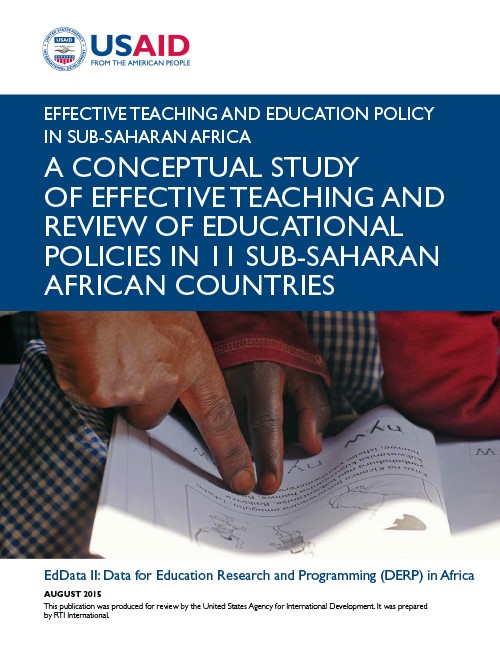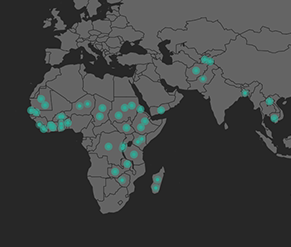
It is no surprise, then, to see that the Sustainable Development Goals include a target (4.1) that seeks to marry access to schooling with a goal that has proven somewhat more elusive: quality. Although quality has been at the heart of education development for decades, the quality problem is starkly evident because 250 million children (more than half of whom have spent at least four years in school) have not been able to learn basic reading and mathematics. Solutions have proven elusive partly because it is a thorny and complex problem, but also because it is a problem that has been neglected in favor of other issues such as access.
Teaching and quality learning are intrinsically linked
With the access problem largely in the past, how do we ensure more quality in schools and classrooms? This question can be approached in many ways, but it is likely that most of the approaches would, in some way or another, include teachers.
Teachers are a key element to educational quality because they orchestrate instructional interactions with and between students around academic content, and these classroom interactions—in an ideal world—influence student learning.
It is assumed, therefore, that teachers and the actions they take in the classroom fundamentally impact students and what they learn. Often we, as a community of education stakeholders, take this assumed relationship so far as to assert that educational systems are only as good as the quality of their teachers.
However, this nearly universal valuation of both teaching and teachers glosses over the sober realization that individual teachers have differential effects on student learning. That is, teachers are either more or less successful at facilitating their students’ progress toward agreed-upon learning outcomes, and therefore fall somewhere along an idealized continuum of teacher “effectiveness.” This has, in turn, swayed the attention of educational policymakers towards the identification and specification of those aspects of teaching and of teachers who are more likely to facilitate student learning. To date, four general areas of the teaching and learning process have been explored as indicative gauges of instructional effectiveness. These areas are teacher characteristics and classroom-level inputs, teacher professionalism and conduct, student learning outcomes, and teaching practice.
Currently, the most prominent—in terms of both research and policy—of the four areas are teacher characteristics and student learning outcomes because these areas are nearly ubiquitously employed to define effective teaching. The student learning outcomes area is particularly emphasized in high- and middle-income countries, especially with the advent of regional and international assessments of student learning, but it is also becoming more commonplace in low-income countries. However, the areas of teacher characteristics and student learning outcomes define effective teaching not on their own terms, but rather as either teachers who possess specific characteristics viewed as profitable for teaching or as teachers whose students make progress against learning outcome metrics. In other words, effective teaching tends to be conflated with either effective teachers (i.e., personal characteristics and professional attributes) or with successful teaching (i.e., those whose students are successful on accepted forms of assessment).
This bidirectional conflation of good teaching with effective teachers and with successful teaching is subtle, but important because it has had disastrous consequences for both education research and policy. Conflating good teaching with effective teachers has led to a sustained focus on how to recruit, train, and support teachers with the requisite traits that are (nearly) assumed a priori to facilitate student learning. Put otherwise, the emphasis has been on equipping a teacher workforce with the personal characteristics that make “good teachers” and has largely treated teachers as important, but perfectly interchangeable components of an educational system.
However, mistaking good teaching with successful teaching has led policymakers to emphasize and place value on information that students can recall and put into practice on formal assessments.
Analyzing effective teaching – a new report
The conflation has also significantly affected the collection and reporting of educational statistics. A new report by the U.S. Agency for International Development’s Data for Education and Research Programming initiative, which involved the review of international, regional, and national data sets, finds that the teacher-centric measures of educational systems that are most widely available and reported on are those that enumerate effective teachers (i.e., teacher characteristics) and successful teaching (i.e., student outcomes). However, very few international databases and assessments, or ministries of education, collect measures about classroom instructional processes. Rather, evidence of classroom practice (and the improvement of it) in Sub-Saharan African countries tends to come from non-governmental sources that work in collaboration with ministries of education, which means that evidence is both piecemeal and variable.
A policy agenda, embraced by the educational development community, could begin to uncouple the conflation between teachers and teaching and could begin to illuminate the instructional practices teachers employ—their pedagogical moves—in classrooms that best facilitate students’ interactions with academic content and that result in learning. This report outlines the following five possible research and policy agenda items:
- Establish baseline practices of quality teaching and desired instructional behavior: Establish baseline practices for classroom teaching that are non-negotiable, but also leave room for professional judgment, improvisation, and flexibility. This approach to policy acknowledges that there are some basic hallmarks of classroom teaching that all teachers should be expected to exhibit in their practice and that these professional norms establish the structure that enables professional learning among teachers about their practice (with some variation depending upon subject and grade).
- Devise measures of, and start collecting data on, the processes of teaching: Start to collect data on specific instructional practices through classroom observation to begin to establish a bank of evidence that would provide insight into teachers’ classroom instruction. Ministries of education could instigate this process by having inspectors travel to schools, talk with teachers, observe lessons, gather data about specific teaching and learning processes in classrooms, and report back to the ministry (while keeping data anonymous). This collection of anonymous instructional data would not have to start at the national level (i.e., in all regions of a given country) and would not necessarily have to involve all teachers in all grades.
- Reconfigure the school day to allow time and space for teachers to work differently: If teachers are expected to work in a different manner than they have in the past, then they must be given both time and space necessary to work in this new model. It is not realistic to assume teachers’ instructional behaviors will be substantially altered if their daily schedules and work profiles remain unchanged. Time can be allotted to teachers by altering any of the following: instructional time (starting or ending times and breaks within the day), class composition (sizes or organization), or teaching responsibilities (job descriptions). All of these considerations are changeable through policies that would be legislated at the national level, but enacted and enforced at the district or local level.
- Allow experimentation with alternative remuneration schemes: Remuneration could be based on what a society values in its teaching profession, such as a teachers responsibilities, professional actions, and functions, as well as the extent to which an individual teacher fulfills these roles. For instance, a society may value professional learning and increases in skill exhibited by teachers. Traditional remuneration schemes would assume that both of these valued commodities increase over time and with training, though it has been argued that this is not necessarily the case. Instead, an alternative remuneration scheme could compensate teachers who provide evidence of their professional learning (not just courses taken) and increases in skill, much like the National Board for Professional Teaching Standards in the United States.
- Encourage pedagogical risk-taking behavior among teaching staff: If we want teachers to overcome natural risk-aversion and adopt new, more ambitious teaching techniques we will have to explicitly encourage teachers to do so. Encouragement could take many forms and is not limited to financial incentives. For example, ministries will probably have to ensure teachers (and prove to them) that there are no professional stakes tied to their immediate performance when practicing more ambitious instructional techniques (i.e., teachers are allotted time and space to practice and develop without preoccupation over the implications the new techniques have on their evaluations). Ministries can also take steps to decrease the uncertainty surrounding new, more ambitious instructional practices by documenting how the practice of early adopters evolves over time (i.e., collecting peer testimonies).
The international education community has achieved tremendous gains in access to education throughout the developing world, but the hard work is clearly far from over.
Now that most students are able to reach the classroom, it falls to us to take the next necessary steps to ensure they walk away with a quality education.
Rethinking what we consider to be effective teaching—and how we facilitate it—will be an integral part of that process.
To download a PDF version of this blog, please click here.

